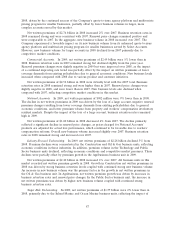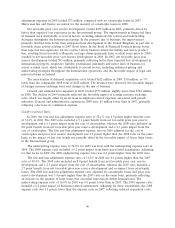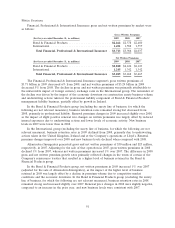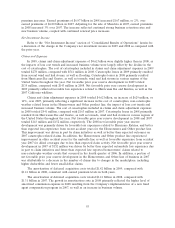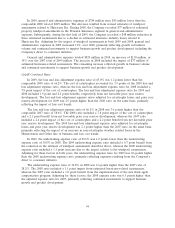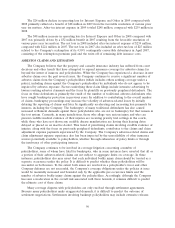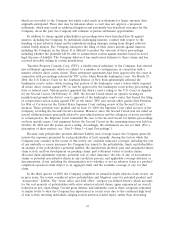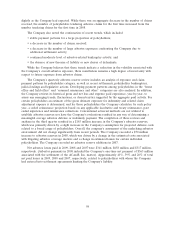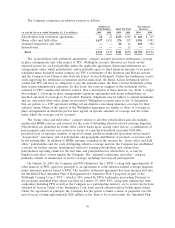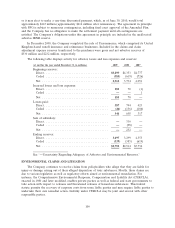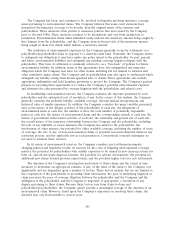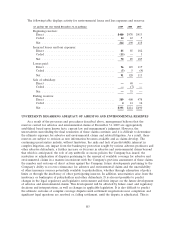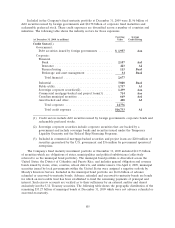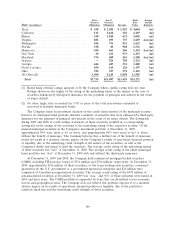Travelers 2009 Annual Report Download - page 109
Download and view the complete annual report
Please find page 109 of the 2009 Travelers annual report below. You can navigate through the pages in the report by either clicking on the pages listed below, or by using the keyword search tool below to find specific information within the annual report.which are favorable to the Company but which could result in settlements for larger amounts than
originally anticipated. There also may be instances where a court may not approve a proposed
settlement, which may result in additional litigation and potentially less beneficial outcomes for the
Company. As in the past, the Company will continue to pursue settlement opportunities.
In addition to claims against policyholders, proceedings have been launched directly against
insurers, including the Company, by individuals challenging insurers’ conduct with respect to the
handling of past asbestos claims and by individuals seeking damages arising from alleged asbestos-
related bodily injuries. The Company anticipates the filing of other direct actions against insurers,
including the Company, in the future. It is difficult to predict the outcome of these proceedings,
including whether the plaintiffs will be able to sustain these actions against insurers based on novel
legal theories of liability. The Company believes it has meritorious defenses to these claims and has
received favorable rulings in certain jurisdictions.
Travelers Property Casualty Corp. (TPC), a wholly-owned subsidiary of the Company, had entered
into settlement agreements, which are subject to a number of contingencies, in connection with a
number of these direct action claims. These settlement agreements had been approved by the court in
connection with proceedings initiated by TPC in the Johns Manville bankruptcy court. On March 29,
2006, the U.S. District Court for the Southern District of New York substantially affirmed the
bankruptcy court’s orders, while vacating that portion of the bankruptcy court’s orders which required
all future direct actions against TPC to first be approved by the bankruptcy court before proceeding in
state or federal court. Various parties appealed the district court’s ruling to the U.S. Court of Appeals
for the Second Circuit. On February 15, 2008, the Second Circuit issued an opinion vacating on
jurisdictional grounds the district court’s approval of the bankruptcy court’s order that barred the filing
of certain direct action claims against TPC in the future. TPC and certain other parties filed Petitions
for Writ of Certiorari in the United States Supreme Court seeking review of the Second Circuit’s
decision. Those petitions were granted and on June 18, 2009, the Supreme Court ruled in favor of the
Company, reversing the Second Circuit’s decision. However, since the Second Circuit had not ruled on
several additional issues principally related to procedural matters and the adequacy of notice provided
to certain parties, the Supreme Court remanded the case to the Second Circuit for further proceedings
on those specific issues. Oral argument before the Second Circuit on the remaining issues was held on
October 22, 2009 and the parties await a ruling. Accordingly, the settlements are not yet final. (For a
description of these matters, see ‘‘Part I—Item 3—Legal Proceedings’’).
Because each policyholder presents different liability and coverage issues, the Company generally
reviews the exposure presented by each policyholder at least annually. Among the factors which the
Company may consider in the course of this review are: available insurance coverage, including the role
of any umbrella or excess insurance the Company has issued to the policyholder; limits and deductibles;
an analysis of the policyholder’s potential liability; the jurisdictions involved; past and anticipated future
claim activity and loss development on pending claims; past settlement values of similar claims;
allocated claim adjustment expense; potential role of other insurance; the role, if any, of non-asbestos
claims or potential non-asbestos claims in any resolution process; and applicable coverage defenses or
determinations, if any, including the determination as to whether or not an asbestos claim is a product/
completed operation claim subject to an aggregate limit and the available coverage, if any, for that
claim.
In the third quarter of 2009, the Company completed its annual in-depth asbestos claim review. As
in prior years, the review considered active policyholders and litigation cases for potential product and
‘‘non-product’’ liability. The ‘‘home office and field office’’ category (as defined below), which accounts
for the vast majority of policyholders with active asbestos-related claims, again experienced an overall
reduction in new claim filings. Overall gross defense and indemnity costs in these categories remained
at similar levels to what the Company has experienced in recent years due to the continued high level
of trial activity involving individuals alleging serious asbestos-related injury, rather than decreasing
97


